Abstract
Key pecking by pigeons was maintained on a chained fixed-interval 4-min (12-min for 1 subject) fixed-ratio 1 schedule of food presentation. Attacks toward a restrained and protected conspecific were recorded. In the first experiment, the amount of food presented per interval was manipulated across phases by varying the number of fixed ratios required in the terminal link of the chain. Measures of attack for all pigeons during the fixed-interval component increased monotonically as a function of food amount. In the second experiment, two different food amounts alternated within each experimental session under a multiple schedule. For both pigeons in this experiment, measures of attack were higher during the component that delivered the larger food amount per interval. The differences in levels of attack induced by the two food amounts in Experiment 2, however, were not as great as in Experiment 1; apparently this was because attack during the first interval of each component was controlled in part (P-5626) or entirely (P-7848) by the reinforcement amount delivered at the end of the previous component. Attack was also a function of the location of the interfood interval within the session. For both pigeons, attack tended to decrease throughout the session. The results of both experiments suggest that attack is an increasing function of reinforcement amount under fixed-interval schedules, but that this function may be influenced by the manner in which reinforcement amount is manipulated, by the duration of the interfood interval, and by the location of the interfood interval within the experimental session. In general, these results are compatible with theories of induced attack and other schedule-induced behavior that emphasize aversive after-effects of reinforcement presentation.
Keywords: schedule-induced attack, schedule-induced behavior, reinforcement amount, fixed-interval schedule, key peck, pigeons
Full text
PDF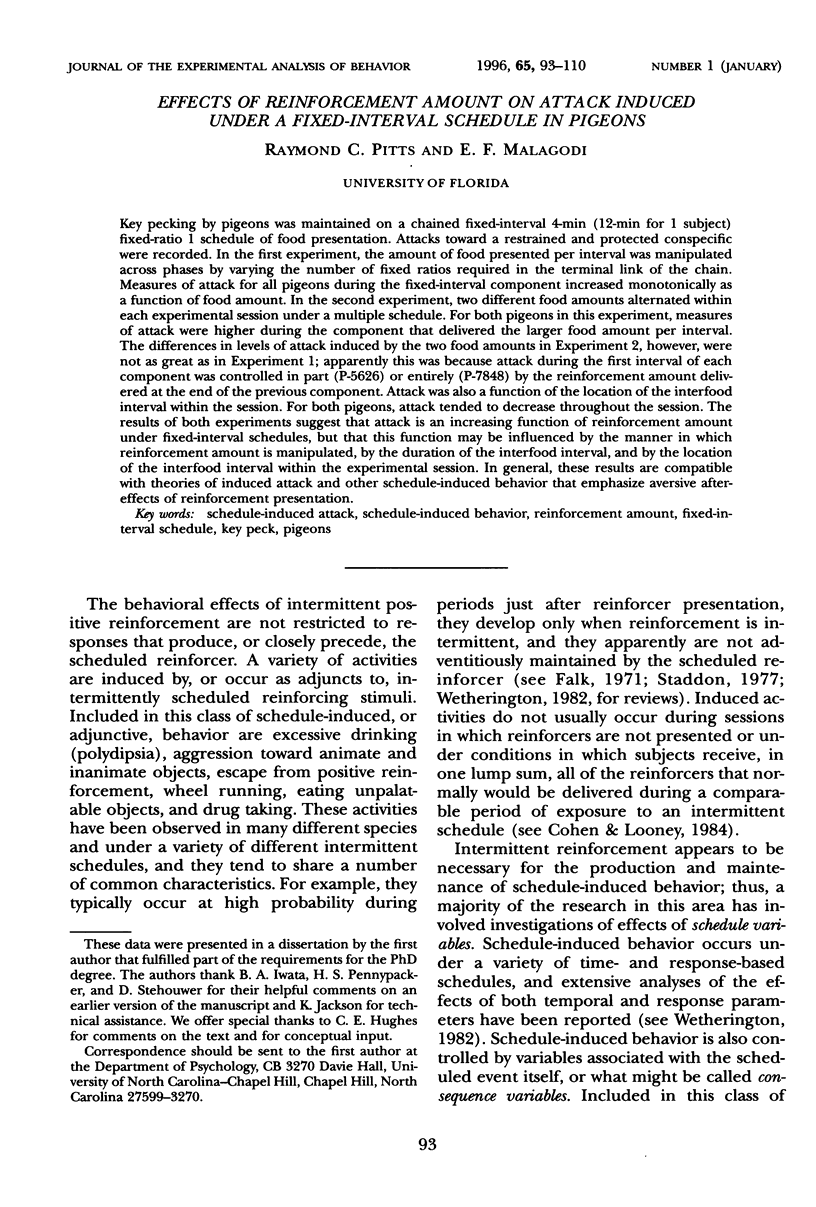
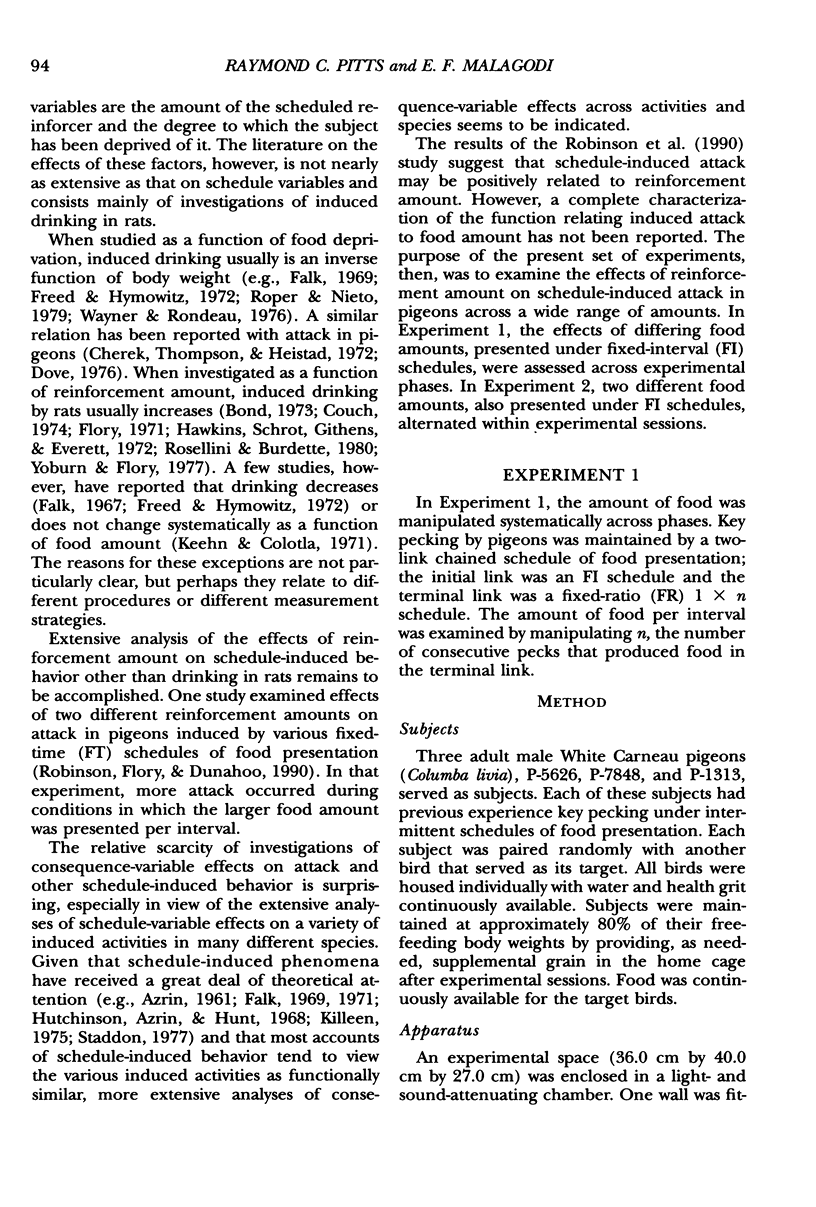


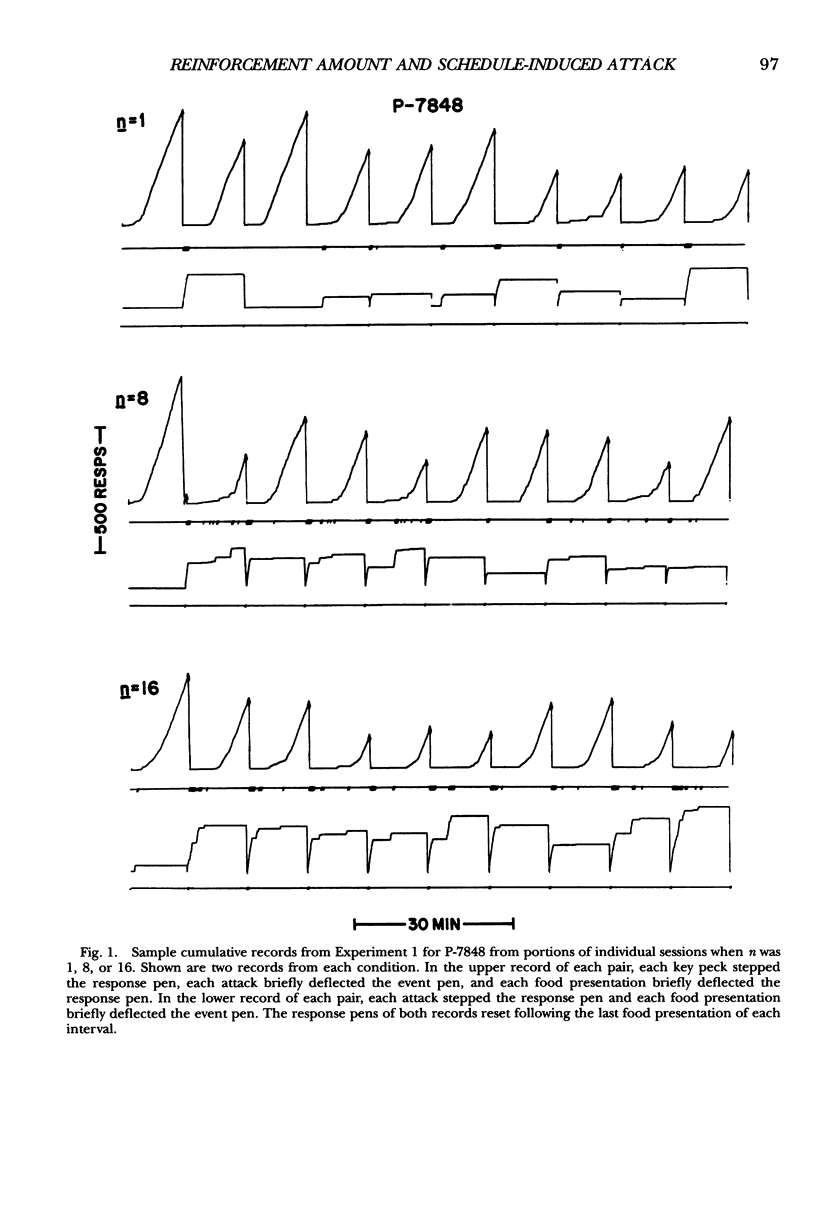
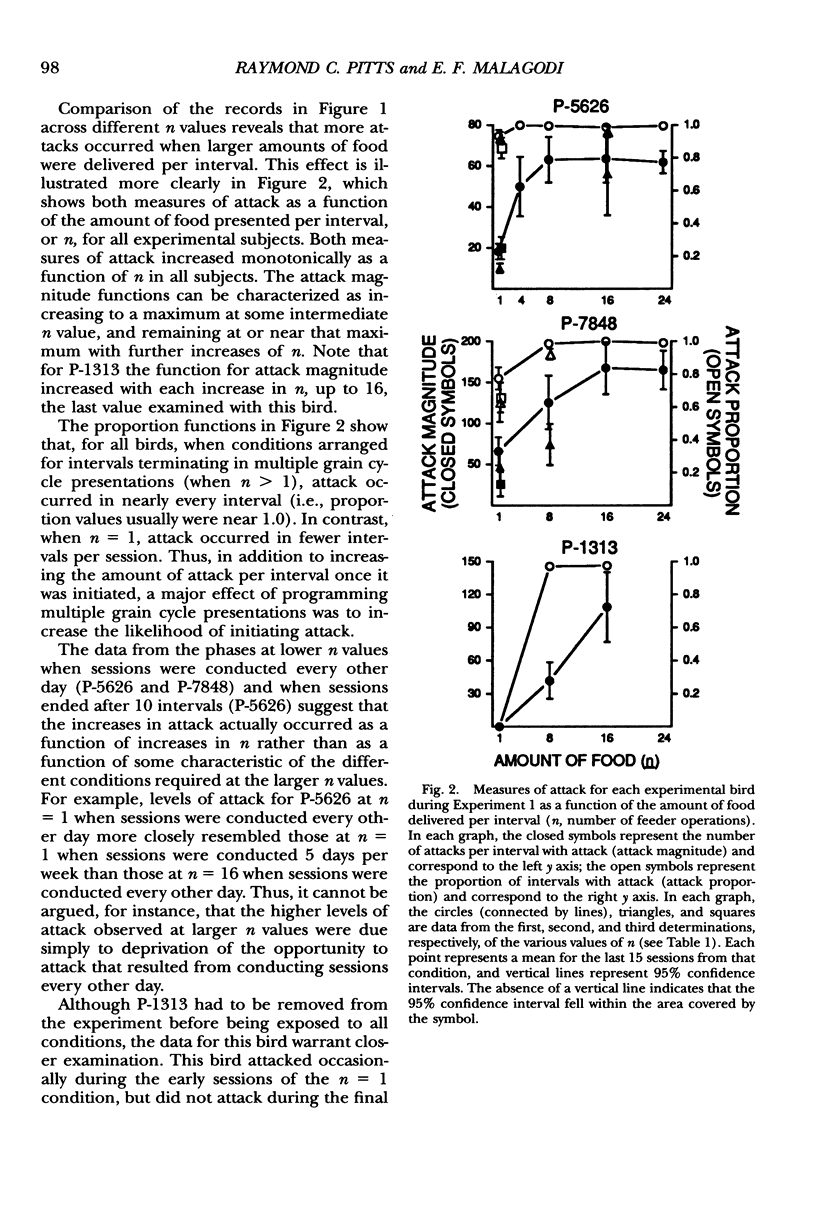
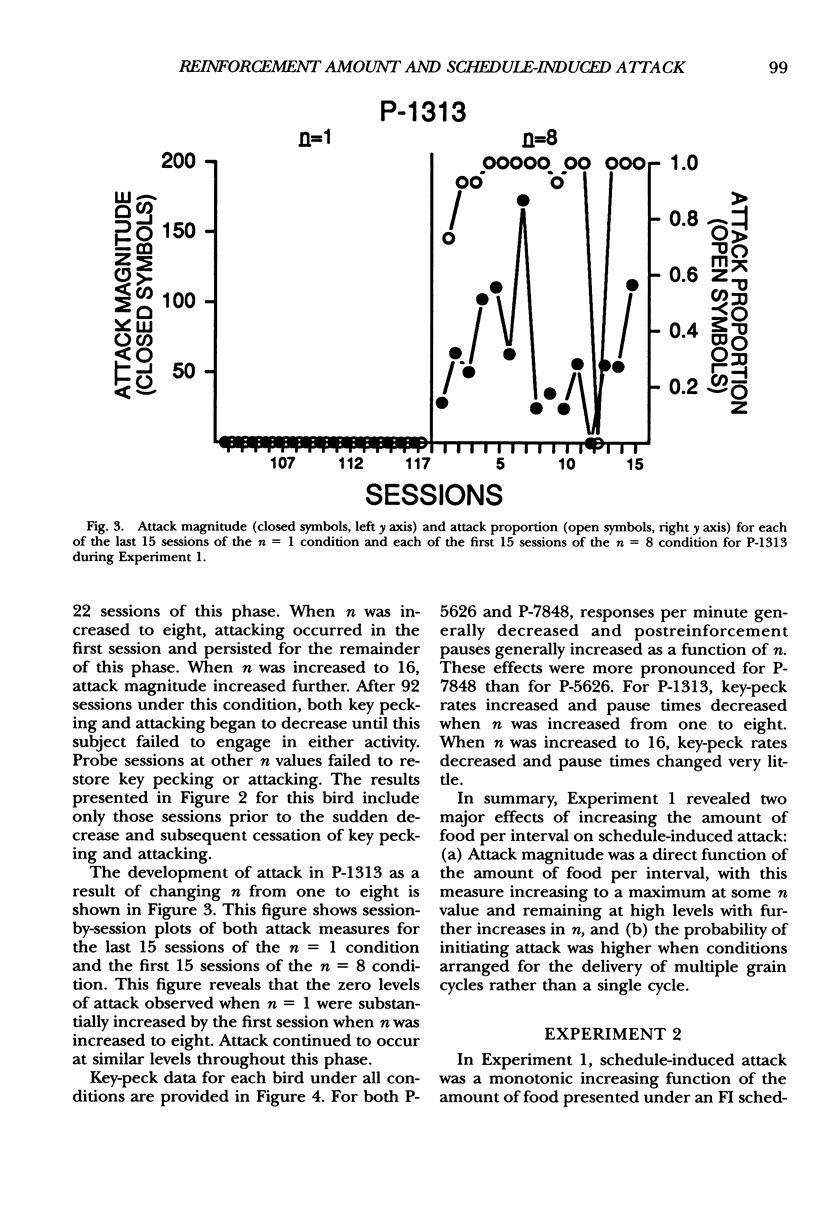
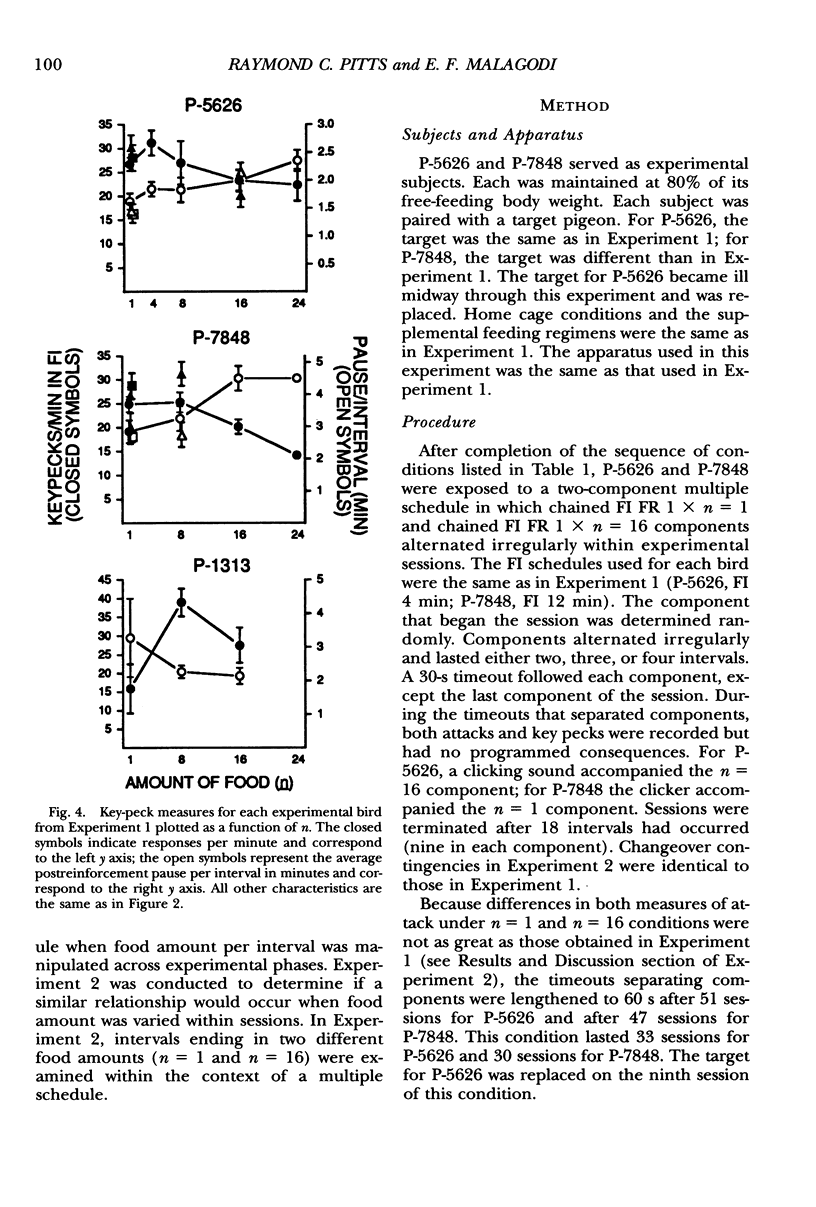

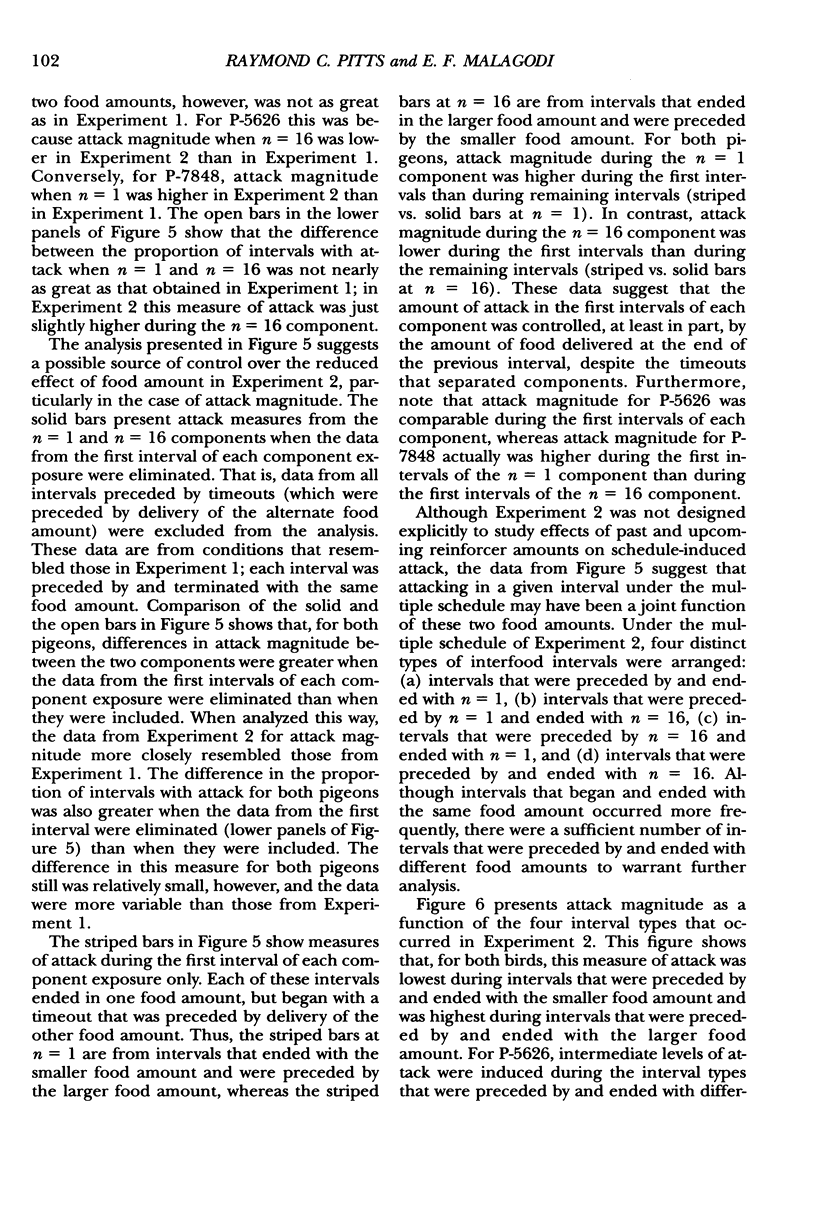
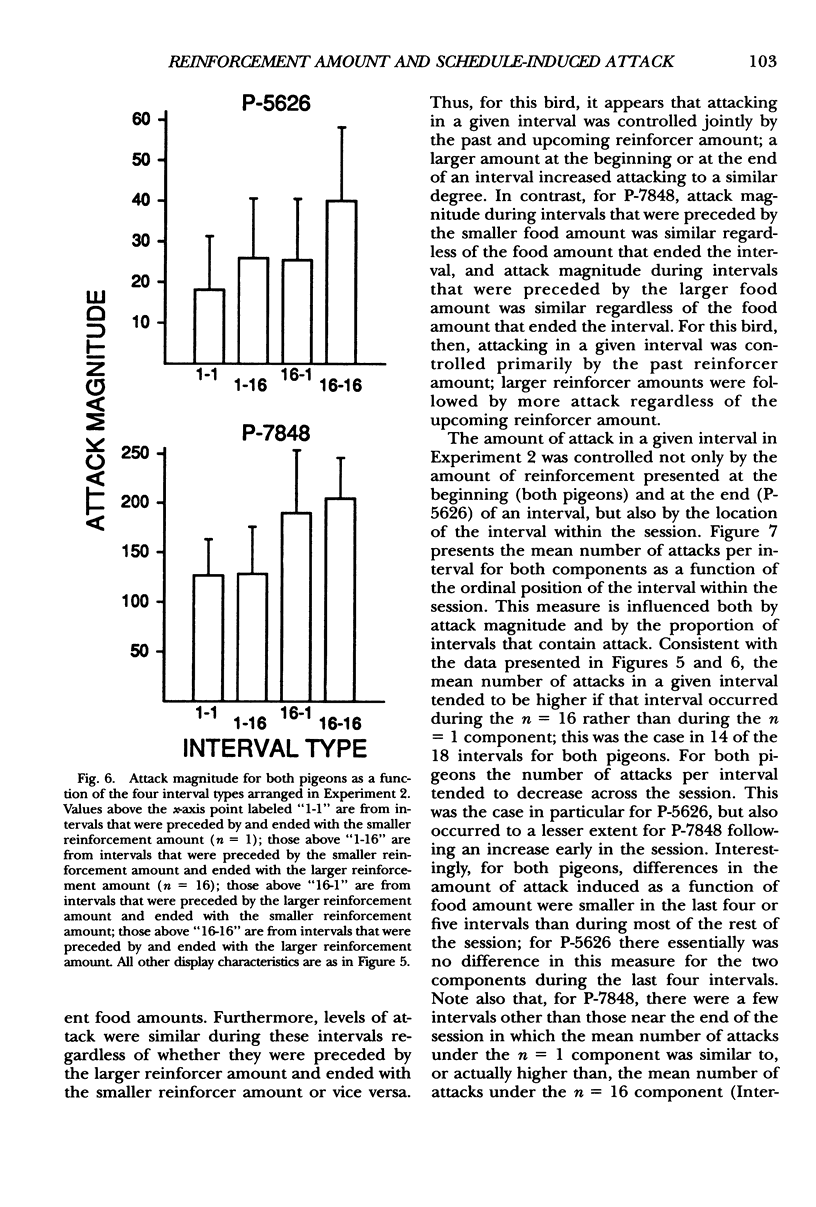
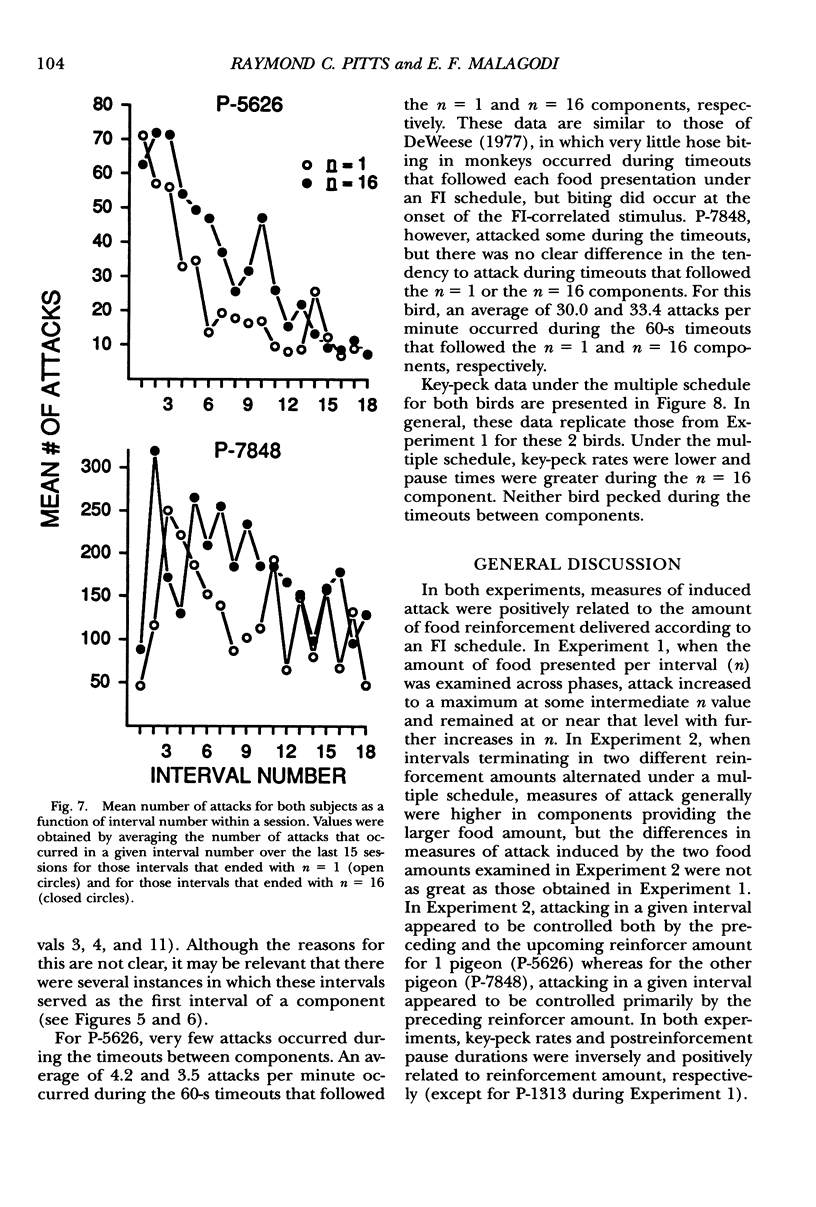
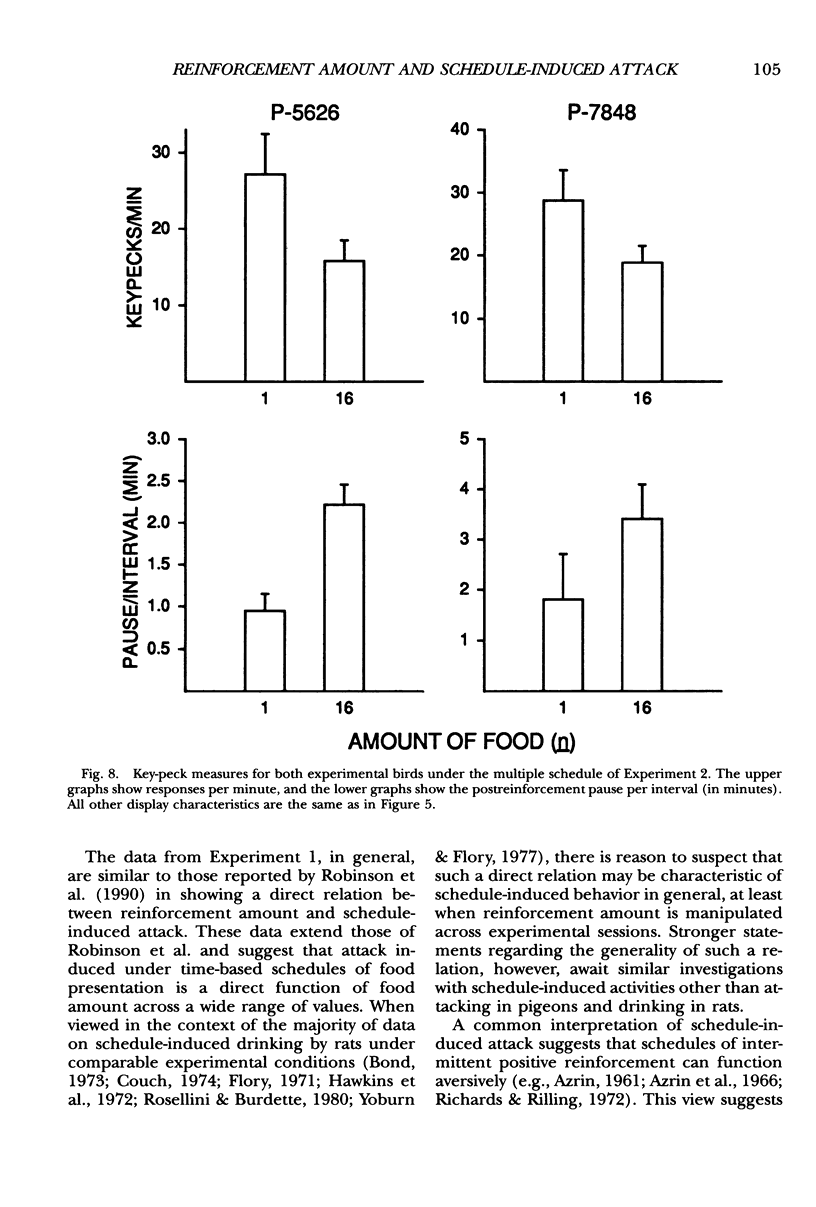

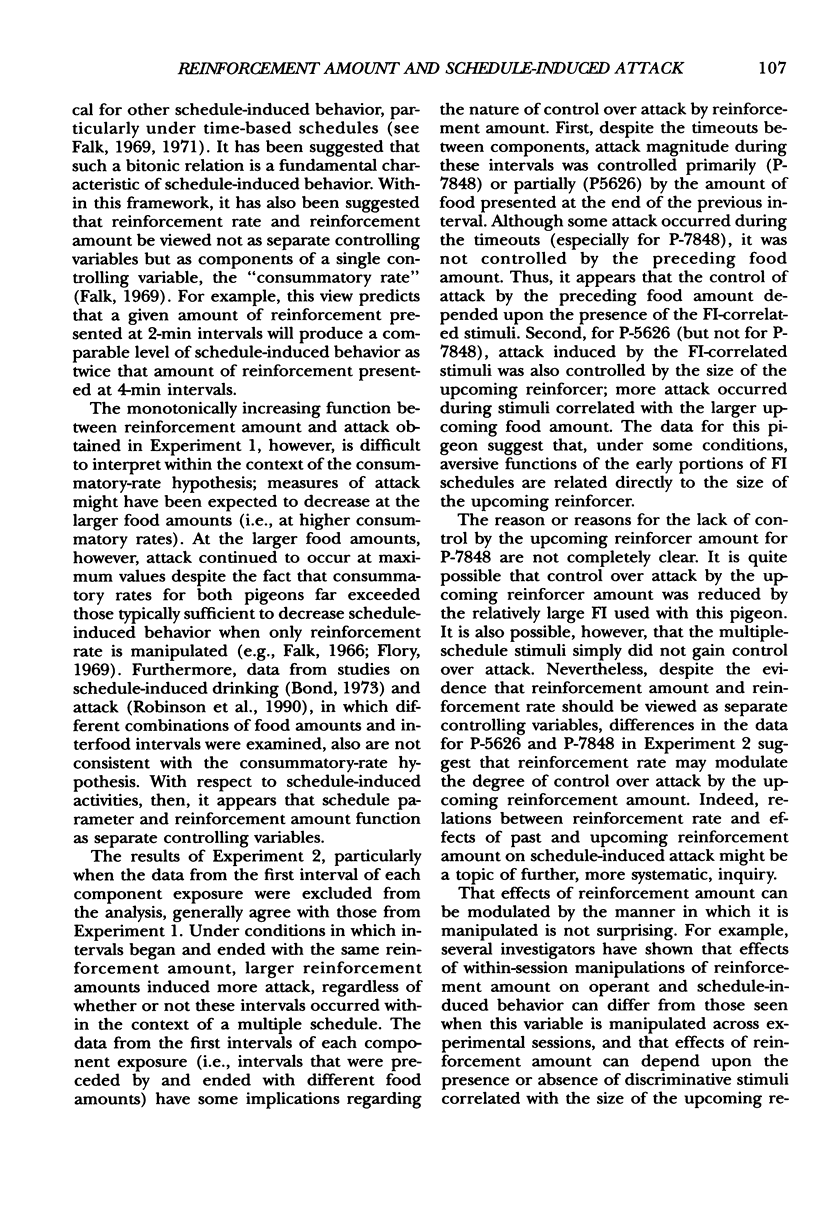
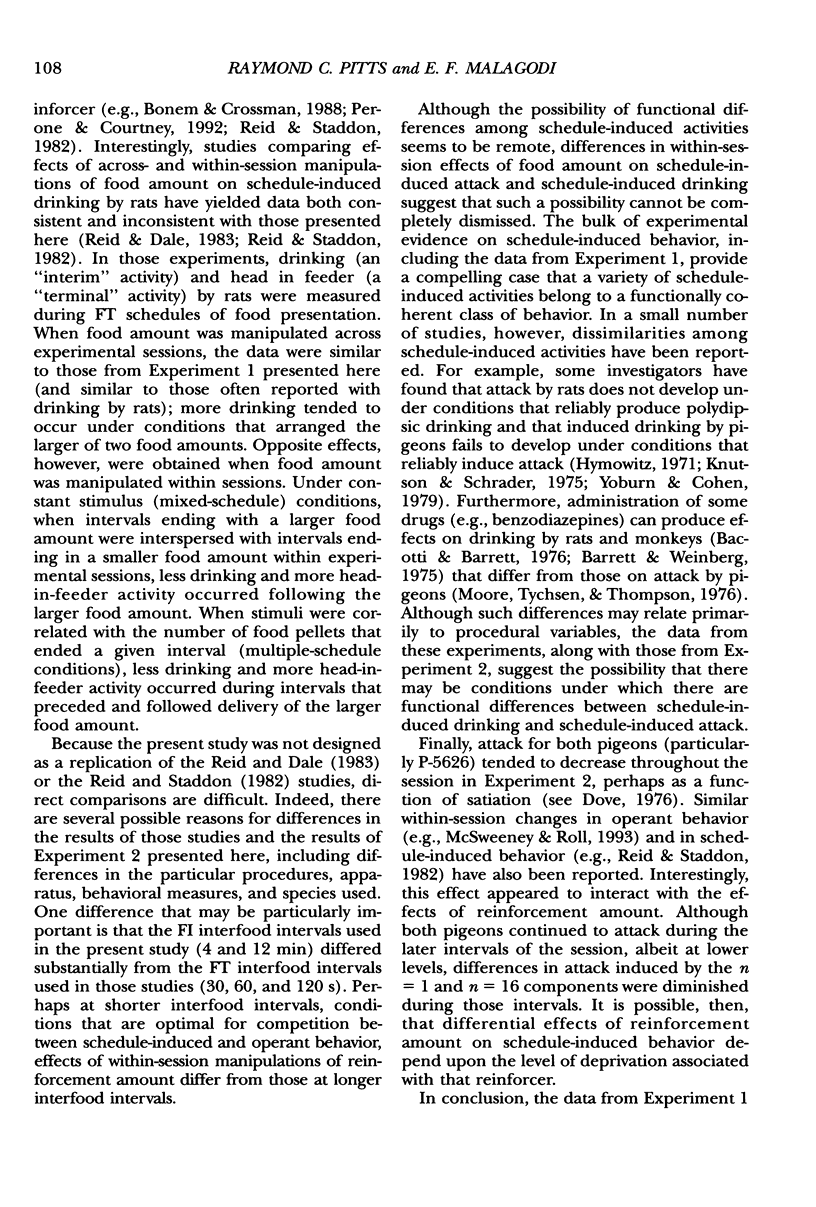
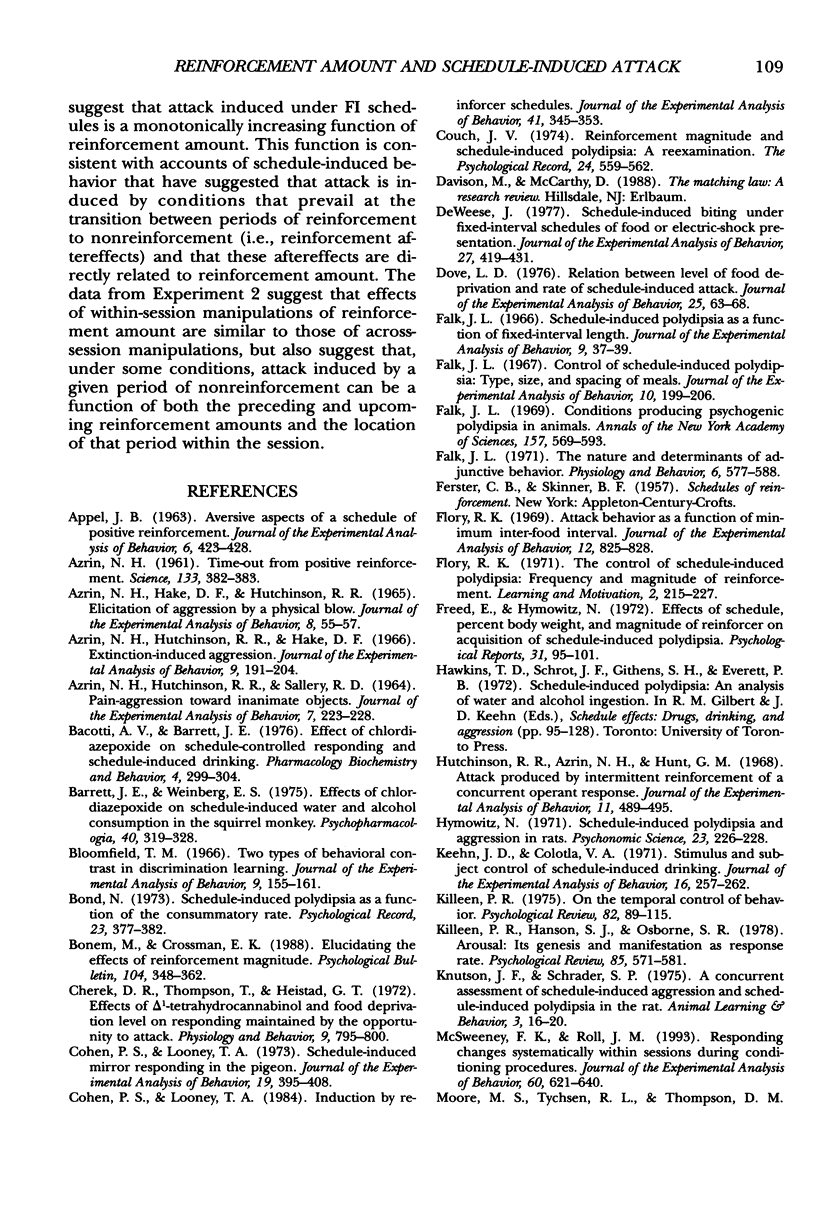
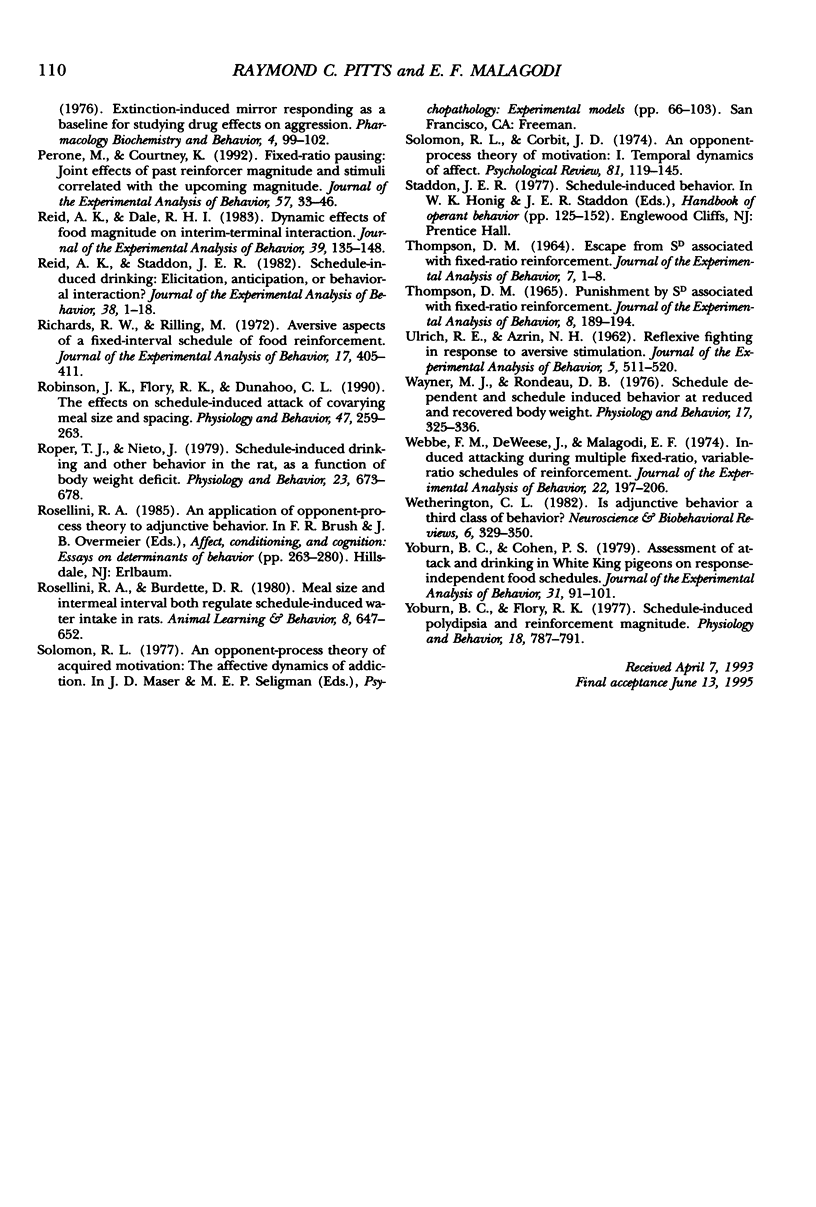
Selected References
These references are in PubMed. This may not be the complete list of references from this article.
- APPEL J. B. Aversive aspects of a schedule of positive reinforcement. J Exp Anal Behav. 1963 Jul;6:423–428. doi: 10.1901/jeab.1963.6-423. [DOI] [PMC free article] [PubMed] [Google Scholar]
- AZRIN N. H., HAKE D. F., HUTCHINSON R. R. ELICITATION OF AGGRESSION BY A PHYSICAL BLOW. J Exp Anal Behav. 1965 Jan;8:55–57. doi: 10.1901/jeab.1965.8-55. [DOI] [PMC free article] [PubMed] [Google Scholar]
- AZRIN N. H., HUTCHINSON R. R., SALLERY R. D. PAIN-AGGRESSION TOWARD INANIMATE OBJECTS. J Exp Anal Behav. 1964 May;7:223–228. doi: 10.1901/jeab.1964.7-223. [DOI] [PMC free article] [PubMed] [Google Scholar]
- AZRIN N. H. Time-out from positive reinforcement. Science. 1961 Feb 10;133(3450):382–383. doi: 10.1126/science.133.3450.382. [DOI] [PubMed] [Google Scholar]
- Azrin N. H., Hutchinson R. R., Hake D. F. Extinction-induced aggression. J Exp Anal Behav. 1966 May;9(3):191–204. doi: 10.1901/jeab.1966.9-191. [DOI] [PMC free article] [PubMed] [Google Scholar]
- Bacotti A. V., Barrett J. E. Effect of chlordiazepoxide on schedule-controlled responding and schedule-induced drinking. Pharmacol Biochem Behav. 1976 Mar;4(3):299–304. doi: 10.1016/0091-3057(76)90245-8. [DOI] [PubMed] [Google Scholar]
- Barrett J. E., Weinberg E. S. Effects of chlordiazepoxide on schedule-induced water and alcohol consumption in the squirrel monkey. Psychopharmacologia. 1975;40(4):319–328. doi: 10.1007/BF00421470. [DOI] [PubMed] [Google Scholar]
- Bloomfield T. M. Two types of behavioral contrast in discrimination learning. J Exp Anal Behav. 1966 Mar;9(2):155–161. doi: 10.1901/jeab.1966.9-155. [DOI] [PMC free article] [PubMed] [Google Scholar]
- Bonem M., Crossman E. K. Elucidating the effects of reinforcement magnitude. Psychol Bull. 1988 Nov;104(3):348–362. doi: 10.1037/0033-2909.104.3.348. [DOI] [PubMed] [Google Scholar]
- Cherek D. R., Thompson T., Heistad G. T. Effects of 1 -tetrahydrocannabinol and food deprivation level on responding maintained by the opportunity to attack. Physiol Behav. 1972 Nov-Dec;9(5):795–800. doi: 10.1016/0031-9384(72)90054-6. [DOI] [PubMed] [Google Scholar]
- Cohen P. S., Looney T. A. Induction by reinforcer schedules. J Exp Anal Behav. 1984 May;41(3):345–353. doi: 10.1901/jeab.1984.41-345. [DOI] [PMC free article] [PubMed] [Google Scholar]
- Cohen P. S., Looney T. A. Schedule-induced mirror responding in the pigeon. J Exp Anal Behav. 1973 May;19(3):395–408. doi: 10.1901/jeab.1973.19-395. [DOI] [PMC free article] [PubMed] [Google Scholar]
- Deweese J. Schedule-induced biting under fixed-interval schedules of food or electric-shock presentation. J Exp Anal Behav. 1977 May;27(3):419–431. doi: 10.1901/jeab.1977.27-419. [DOI] [PMC free article] [PubMed] [Google Scholar]
- Dove L. D. Relation between level of food deprivation and rate of schedule-induced attack. J Exp Anal Behav. 1976 Jan;25(1):63–68. doi: 10.1901/jeab.1976.25-63. [DOI] [PMC free article] [PubMed] [Google Scholar]
- Falk J. L. Conditions producing psychogenic polydipsia in animals. Ann N Y Acad Sci. 1969 May 15;157(2):569–593. doi: 10.1111/j.1749-6632.1969.tb12908.x. [DOI] [PubMed] [Google Scholar]
- Falk J. L. Control of schedule-induced polydipsia: type, size, and spacing of meals. J Exp Anal Behav. 1967 Mar;10(2):199–206. doi: 10.1901/jeab.1967.10-199. [DOI] [PMC free article] [PubMed] [Google Scholar]
- Falk J. L. Schedule-induced polydipsia as a function of fixed interval length. J Exp Anal Behav. 1966 Jan;9(1):37–39. doi: 10.1901/jeab.1966.9-37. [DOI] [PMC free article] [PubMed] [Google Scholar]
- Falk J. L. The nature and determinants of adjunctive behavior. Physiol Behav. 1971 May;6(5):577–588. doi: 10.1016/0031-9384(71)90209-5. [DOI] [PubMed] [Google Scholar]
- Flory R. Attack behavior as a function of minimum inter-food interval. J Exp Anal Behav. 1969 Sep;12(5):825–828. doi: 10.1901/jeab.1969.12-825. [DOI] [PMC free article] [PubMed] [Google Scholar]
- Freed E. X., Hymowitz N. Effects of schedule, percent body weight, and magnitude of reinforcer on acquisition of schedule-induced polydipsia. Psychol Rep. 1972 Aug;31(1):95–101. doi: 10.2466/pr0.1972.31.1.95. [DOI] [PubMed] [Google Scholar]
- Hutchinson R. R., Azrin N. H., Hunt G. M. Attack produced by intermittent reinforcement of a concurrent operant response. J Exp Anal Behav. 1968 Jul;11(4):489–495. doi: 10.1901/jeab.1968.11-489. [DOI] [PMC free article] [PubMed] [Google Scholar]
- Keehn J. D., Colotla V. A. Stimulus and subject control of schedule-induced drinking. J Exp Anal Behav. 1971 Sep;16(2):257–262. doi: 10.1901/jeab.1971.16-257. [DOI] [PMC free article] [PubMed] [Google Scholar]
- Killeen P. R., Hanson S. J., Osborne S. R. Arousal: its genesis and manifestation as response rate. Psychol Rev. 1978 Nov;85(6):571–581. [PubMed] [Google Scholar]
- McSweeney F. K., Roll J. M. Responding changes systematically within sessions during conditioning procedures. J Exp Anal Behav. 1993 Nov;60(3):621–640. doi: 10.1901/jeab.1993.60-621. [DOI] [PMC free article] [PubMed] [Google Scholar]
- Perone M., Courtney K. Fixed-ratio pausing: Joint effects of past reinforcer magnitude and stimuli correlated with upcoming magnitude. J Exp Anal Behav. 1992 Jan;57(1):33–46. doi: 10.1901/jeab.1992.57-33. [DOI] [PMC free article] [PubMed] [Google Scholar]
- Reid A. K., Dale R. H. Dynamic effects of food magnitude on interim-terminal interaction. J Exp Anal Behav. 1983 Jan;39(1):135–148. doi: 10.1901/jeab.1983.39-135. [DOI] [PMC free article] [PubMed] [Google Scholar]
- Reid A. K., Staddon J. E. Schedule-induced drinking: Elicitation, anticipation, or behavioral interaction? J Exp Anal Behav. 1982 Jul;38(1):1–18. doi: 10.1901/jeab.1982.38-1. [DOI] [PMC free article] [PubMed] [Google Scholar]
- Richards R. W., Rilling M. Aversive aspects of a fixed-interval schedule of food reinforcement. J Exp Anal Behav. 1972 May;17(3):405–411. doi: 10.1901/jeab.1972.17-405. [DOI] [PMC free article] [PubMed] [Google Scholar]
- Robinson J. K., Flory R. K., Dunahoo C. L. The effects on schedule-induced attack of covarying meal size and spacing. Physiol Behav. 1990 Feb;47(2):259–263. doi: 10.1016/0031-9384(90)90140-y. [DOI] [PubMed] [Google Scholar]
- Roper T. J., Nieto J. Schedule-induced drinking and other behavior in the rat, as a function of body weight deficit. Physiol Behav. 1979 Oct;23(4):673–678. doi: 10.1016/0031-9384(79)90159-8. [DOI] [PubMed] [Google Scholar]
- Solomon R. L., Corbit J. D. An opponent-process theory of motivation. I. Temporal dynamics of affect. Psychol Rev. 1974 Mar;81(2):119–145. doi: 10.1037/h0036128. [DOI] [PubMed] [Google Scholar]
- THOMPSON D. M. ESCAPE FROM SD ASSOCIATED WITH FIXED-RATIO REINFORCEMENT. J Exp Anal Behav. 1964 Jan;7:1–8. doi: 10.1901/jeab.1964.7-1. [DOI] [PMC free article] [PubMed] [Google Scholar]
- THOMPSON D. M. PUNISHMENT BY SD ASSOCIATED WITH FIXED-RATIO REINFORCEMENT. J Exp Anal Behav. 1965 May;8:189–194. doi: 10.1901/jeab.1965.8-189. [DOI] [PMC free article] [PubMed] [Google Scholar]
- ULRICH R. E., AZRIN N. H. Reflexive fighting in response to aversive stimulation. J Exp Anal Behav. 1962 Oct;5:511–520. doi: 10.1901/jeab.1962.5-511. [DOI] [PMC free article] [PubMed] [Google Scholar]
- Wayner M. J., Rondeau D. B. Schedule dependent and schedule induced behavior at reduced and recovered body weight. Physiol Behav. 1976 Aug;17(2):325–336. doi: 10.1016/0031-9384(76)90083-4. [DOI] [PubMed] [Google Scholar]
- Webbe F. M., Deweese J., Malagodi E. F. Induced attack during multiple fixed-ratio, variable-ratio schedules of reinforcement. J Exp Anal Behav. 1974 Jul;22(1):197–206. doi: 10.1901/jeab.1974.22-197. [DOI] [PMC free article] [PubMed] [Google Scholar]
- Wetherington C. L. Is adjunctive behavior a third class of behavior? Neurosci Biobehav Rev. 1982 Fall;6(3):329–350. doi: 10.1016/0149-7634(82)90045-8. [DOI] [PubMed] [Google Scholar]
- Yoburn B. C., Cohen P. S. Assessment of attack and drinking in White King pigeons on response-independent food schedules. J Exp Anal Behav. 1979 Jan;31(1):91–101. doi: 10.1901/jeab.1979.31-91. [DOI] [PMC free article] [PubMed] [Google Scholar]
- Yoburn B. C., Flory R. K. Schedule-induced polydipsia and reinforcement magnitude. Physiol Behav. 1977 May;18(5):787–791. doi: 10.1016/0031-9384(77)90184-6. [DOI] [PubMed] [Google Scholar]


